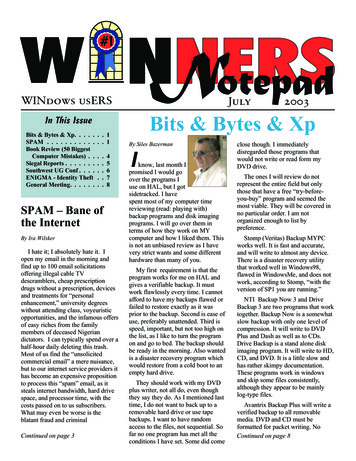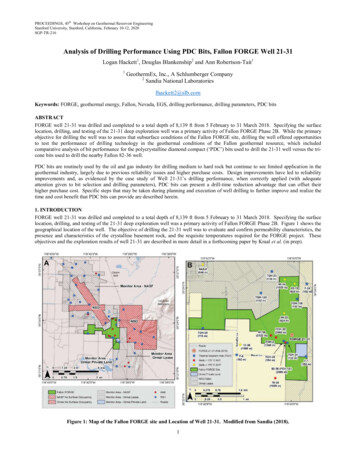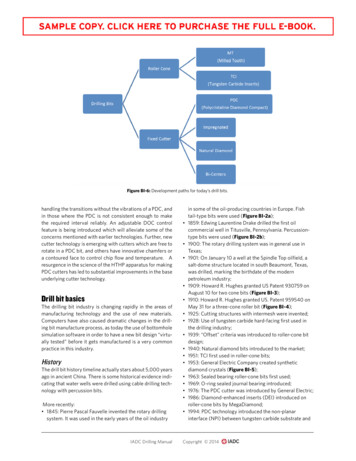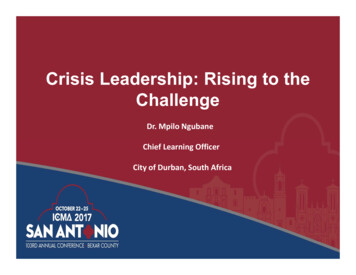
Transcription
00 0137135599 FM.qxd5/7/081:00 PMPage iiiBlown to BitsYour Life, Liberty,and Happiness Afterthe Digital ExplosionHal AbelsonKen LedeenHarry LewisUpper Saddle River, NJ Boston Indianapolis San FranciscoNew York Toronto Montreal London Munich Paris MadridCape Town Sydney Tokyo Singapore Mexico City
00 0137135599 FM.qxd5/7/081:00 PMPage ivMany of the designations used by manufacturers and sellers to distinguish their products areclaimed as trademarks. Where those designations appear in this book, and the publisher wasaware of a trademark claim, the designations have been printed with initial capital letters or inall capitals.The authors and publisher have taken care in the preparation of this book, but make noexpressed or implied warranty of any kind and assume no responsibility for errors or omissions.No liability is assumed for incidental or consequential damages in connection with or arisingout of the use of the information or programs contained herein.The publisher offers excellent discounts on this book when ordered in quantity for bulkpurchases or special sales, which may include electronic versions and/or custom covers andcontent particular to your business, training goals, marketing focus, and branding interests. Formore information, please contact:U.S. Corporate and Government Sales(800) 382-3419corpsales@pearsontechgroup.comFor sales outside the United States, please contact:International Salesinternational@pearson.comVisit us on the Web: www.informit.com/awLibrary of Congress Cataloging-in-Publication Data:Abelson, Harold.Blown to bits : your life, liberty, and happiness after the digital explosion / Hal Abelson,Ken Ledeen, Harry Lewis.p. cm.ISBN 0-13-713559-9 (hardback : alk. paper) 1. Computers and civilization. 2. Informationtechnology—Technological innovations. 3. Digital media. I. Ledeen, Ken, 1946- II. Lewis,Harry R. III. Title.QA76.9.C66A245 2008303.48’33—dc222008005910Copyright 2008 Hal Abelson, Ken Ledeen, and Harry LewisThis work is licensed under the Creative Commons Attribution-Noncommercial-Share Alike3.0 United States License. To view a copy of this license 3.0/us/ or send a letter to Creative Commons171 Second Street, Suite 300, San Francisco, California, 94105, USA.For information regarding permissions, write to:Pearson Education, Inc.Rights and Contracts Department501 Boylston Street, Suite 900Boston, MA 02116Fax (617) 671 3447
00 0137135599 FM.qxd11/21/0810:32 AMPage vISBN-13: 978-0-13-713559-2ISBN-10: 0-13-713559-9Text printed in the United States on recycled paper at RR Donnelley in Crawfordsville, Indiana.Third printing December 2008This Book Is Safari EnabledThe Safari Enabled icon on the cover of your favorite technology book means the book isavailable through Safari Bookshelf. When you buy this book, you get free access to the onlineedition for 45 days.Safari Bookshelf is an electronic reference library that lets you easily search thousands oftechnical books, find code samples, download chapters, and access technical informationwhenever and wherever you need it.To gain 45-day Safari Enabled access to this book: Go to http://www.informit.com/onlineedition Complete the brief registration form Enter the coupon code 9SD6-IQLD-ZDNI-AGEC-AG6LIf you have difficulty registering on Safari Bookshelf or accessing the online edition, pleasee-mail customer-service@safaribooksonline.com.Editor in ChiefMark TaubIndexerErika MillenAcquisitions EditorGreg DoenchProofreaderWilliams Woods Publishing ServicesDevelopment EditorMichael ThurstonPublishing CoordinatorMichelle HousleyManaging EditorGina KanouseInterior Designer and CompositionNonie RatcliffSenior Project EditorKristy HartCover DesignerChuti PrasertsithCopy EditorWater Crest Publishing, Inc.
01 0137135599 ch01.qxd4/16/081:19 PMPage 1CHAPTER 1Digital ExplosionWhy Is It Happening, andWhat Is at Stake?On September 19, 2007, while driving alone near Seattle on her way to work,Tanya Rider went off the road and crashed into a ravine.* For eight days, shewas trapped upside down in the wreckage of her car. Severely dehydrated andsuffering from injuries to her leg and shoulder, she nearly died of kidney failure. Fortunately, rescuers ultimately found her. She spent months recuperating in a medical facility. Happily, she was able to go home for Christmas.Tanya’s story is not just about a woman, an accident, and a rescue. It is astory about bits—the zeroes and ones that make up all our cell phone conversations, bank records, and everything else that gets communicated or storedusing modern electronics.Tanya was found because cell phone companies keep records of cell phonelocations. When you carry your cell phone, it regularly sends out a digital“ping,” a few bits conveying a “Here I am!” message. Your phone keeps “pinging” as long as it remains turned on. Nearby cell phone towers pick up thepings and send them on to your cellular service provider. Your cell phonecompany uses the pings to direct your incoming calls to the right cell phonetowers. Tanya’s cell phone company, Verizon, still had a record of the lastlocation of her cell phone, even after the phone had gone dead. That is howthe police found her.So why did it take more than a week?If a woman disappears, her husband can’t just make the police find her bytracing her cell phone records. She has a privacy right, and maybe she hasgood reason to leave town without telling her husband where she is going. In* Citations of facts and sources appear at the end of the book. A page number and a phraseidentify the passage.1
01 0137135599 ch01.qxd24/16/081:19 PMPage 2BLOWN TO BITSTanya’s case, her bank account showed some activity (more bits!) after herdisappearance, and the police could not classify her as a “missing person.” Infact, that activity was by her husband. Through some misunderstanding, thepolice thought he did not have access to the account. Only when the policesuspected Tanya’s husband of involvement in her disappearance did theyhave legal access to the cell phone records. Had they continued to act on thetrue presumption that he was blameless, Tanya might never have been found.New technologies interacted in an odd way with evolving standards of privacy, telecommunications, and criminal law. The explosive combinationalmost cost Tanya Rider her life. Her story is dramatic, but every day weencounter unexpected consequences of data flows that could not have happened a few years ago.When you have finished reading this book, you should see the world in adifferent way. You should hear a story from a friend or on a newscast and sayto yourself, “that’s really a bits story,” even if no one mentions anything digital. The movements of physical objects and the actions of flesh and bloodhuman beings are only the surface. To understand what is really going on, youhave to see the virtual world, the eerie flow of bits steering the events of life.This book is your guide to this new world.The Explosion of Bits, and Everything ElseThe world changed very suddenly. Almost everything is stored in a computersomewhere. Court records, grocery purchases, precious family photos, pointless radio programs . Computers contain a lot of stuff that isn’t useful todaybut somebody thinks might someday come in handy. It is all being reducedto zeroes and ones—“bits.” The bits are stashed on disks of home computersand in the data centers of big corporations and government agencies. Thedisks can hold so many bits that there is no need to pick and choose whatgets remembered.So much digital information, misinformation, data, and garbage is beingsquirreled away that most of it will be seen only by computers, never byhuman eyes. And computers are getting better and better at extracting meaning from all those bits—finding patterns that sometimes solve crimes andmake useful suggestions, and sometimes reveal things about us we did notexpect others to know.The March 2008 resignation of Eliot Spitzer as Governor of New York is abits story as well as a prostitution story. Under anti-money laundering (AML)rules, banks must report transactions of more than 10,000 to federal regulators. None of Spitzer’s alleged payments reached that threshold, but his
01 0137135599 ch01.qxd4/16/081:19 PMPage 3CHAPTER1DIGITAL EXPLOSION3bank’s computer found that transfers of smaller sums formed a suspiciouspattern. The AML rules exist to fight terrorism and organized crime. But whilethe computer was monitoring small banking transactions in search ofbig-time crimes, it exposed a simple payment for services rendered thatbrought down the Governor.Once something is on a computer, it can replicate and move around theworld in a heartbeat. Making a million perfect copies takes but an instant—copies of things we want everyone in the world to see, and also copies ofthings that weren’t meant to be copied at all.The digital explosion is changing the world as much as printing once did—and some of the changes are catching us unaware, blowing to bits ourassumptions about the way the world works.When we observe the digital explosion at all, it can seem benign, amusing, or even utopian. Instead of sending prints through the mail to Grandma,we put pictures of our children on a photo album web site such as Flickr. Thennot only can Grandma see them—so can Grandma’s friends and anyone else.So what? They are cute and harmless. But suppose a tourist takes a vacationsnapshot and you just happen to appear in the background, at a restaurantwhere no one knew you were dining. If the tourist uploads his photo, thewhole world could know where you were, and when you were there.Data leaks. Credit card records are supposed to stay locked up in a datawarehouse, but escape into the hands of identity thieves. And we sometimesgive information away just because we get something back for doing so. Acompany will give you free phone calls to anywhere in the world—if youdon’t mind watching ads for the products its computers hear you talkingabout.And those are merely things that are happening today. The explosion, andthe social disruption it will create, have barely begun.We already live in a world in which there is enough memory just in digital cameras to store every word of every book in the Library of Congress ahundred times over. So much email is being sent that it could transmit thefull text of the Library of Congress in ten minutes. Digitized pictures andsounds take more space than words, so emailing all the images, movies, andsounds might take a year—but that is just today. The explosive growth is stillhappening. Every year we can store more information, move it more quickly,and do far more ingenious things with it than we could the year before.So much disk storage is being produced every year that it could be used torecord a page of information, every minute or two, about you and every otherhuman being on earth. A remark made long ago can come back to haunt apolitical candidate, and a letter jotted quickly can be a key discovery for a
01 0137135599 ch01.qxd44/16/081:19 PMPage 4BLOWN TO BITSbiographer. Imagine what it would mean to record every word every humanbeing speaks or writes in a lifetime. The technological barrier to that hasalready been removed: There is enough storage to remember it all. Shouldany social barrier stand in the way?Sometimes things seem to work both better and worse than they used to.A “public record” is now very public—before you get hired in Nashville,Tennessee, your employer can figure out if you were caught ten years agotaking an illegal left turn in Lubbock, Texas. The old notion of a “sealed courtrecord” is mostly a fantasy in a world where any tidbit of information isduplicated, cataloged, and moved around endlessly. With hundreds of TV andradio stations and millions of web sites, Americans love the variety of newssources, but are still adjusting uncomfortably to the displacement of moreauthoritative sources. In China, the situation is reversed: The technology creates greater government control of the information its citizens receive, andbetter tools for monitoring their behavior.This book is about how the digital explosion is changing everything. Itexplains the technology itself—why it creates so many surprises and whythings often don’t work the way we expect them to. It is also about things theinformation explosion is destroying: old assumptions about our privacy,about our identity, and about who is in control of our lives. It’s about howwe got this way, what we are losing, and what remains that society still hasa chance to put right. The digital explosion is creating both opportunities andrisks. Many of both will be gone in a decade, settled one way or another.Governments, corporations, and other authorities are taking advantage of thechaos, and most of us don’t even see it happening. Yet we all have a stake inthe outcome. Beyond the science, the history, the law, and the politics, thisbook is a wake-up call. The forces shaping your future are digital, and youneed to understand them.The Koans of BitsBits behave strangely. They travel almost instantaneously, and they takealmost no space to store. We have to use physical metaphors to make themunderstandable. We liken them to dynamite exploding or water flowing. Weeven use social metaphors for bits. We talk about two computers agreeing onsome bits, and about people using burglary tools to steal bits. Getting the rightmetaphor is important, but so is knowing the limitations of our metaphors. Animperfect metaphor can mislead as much as an apt metaphor can illuminate.
01 0137135599 ch01.qxd4/16/081:19 PMPage 5CHAPTER1DIGITAL EXPLOSION5CLAUDE SHANNONClaude Shannon (1916–2001) is the undisputed founding figure of information andcommunication theory. While working at BellTelephone Laboratories after the SecondWorld War, he wrote the seminal paper, “Amathematical theory of communication,”which foreshadowed much of the subsequentdevelopment of digital technologies.Published in 1948, this paper gave birth tothe now-universal realization that the bit isthe natural unit of information, and to theuse of the term.Alcatel-Lucent, on2 lg.jpeg.We offer seven truths about bits. We call them “koans” because they areparadoxes, like the Zen verbal puzzles that provoke meditation and enlightenment. These koans are oversimplifications and over-generalizations. Theydescribe a world that is developing but hasn’t yet fully emerged. But eventoday they are truer than we often realize. These themes will echo throughour tales of the digital explosion.Koan 1: It’s All Just BitsYour computer successfully creates the illusion that it contains photographs,letters, songs, and movies. All it really contains is bits, lots of them, patternedin ways you can’t see. Your computer was designed to store just bits—all thefiles and folders and different kinds of data are illusions created by computerprogrammers. When you send an email containing a photograph, the computers that handle your message as it flows through the Internet have no ideathat what they are handling is part text and part graphic. Telephone calls arealso just bits, and that has helped create competition—traditional phone companies, cell phone companies, cable TV companies, and Voice over IP (VoIP)service providers can just shuffle bits around to each other to complete calls.The Internet was designed to handle just bits, not emails or attachments,which are inventions of software engineers. We couldn’t live without thosemore intuitive concepts, but they are artifices. Underneath, it’s all just bits.This koan is more consequential than you might think. Consider the storyof Naral Pro-Choice America and Verizon Wireless. Naral wanted to form a
01 0137135599 ch01.qxd64/16/081:19 PMPage 6BLOWN TO BITStext messaging group to send alerts to its members. Verizon decided not toallow it, citing the “controversial or unsavory” things the messages mightcontain. Text message alert groups for political candidates it would allow, butnot for political causes it deemed controversial. Had Naral simply wantedtelephone service or an 800 number, Verizon would have had no choice.Telephone companies were long ago declared “common carriers.” Like railroads, phone companies are legally prohibited from picking and choosingcustomers from among those who want their services. In the bits world, thereis no difference between a text message and a wireless phone call. It’s all justbits, traveling through the air by radio waves. But the law hasn’t caught upto the technology. It doesn’t treat all bits the same, and the common carriagerules for voice bits don’t apply to text message bits.Verizon backed down in the caseof Naral, but not on the principle. AEXCLUSIVE AND RIVALROUSphone company can do whatever itthinks will maximize its profits inEconomists would say that bits,deciding whose messages to distribunless controlled somehow, tend toute. Yet no sensible engineering disbe non-exclusive (once a few peotinction can be drawn between textple have them, it is hard to keepmessages, phone calls, and any otherthem from others) and nonbits traveling through the digital airrivalrous (when someone gets themwaves.from me, I don’t have any less). In aletter he wrote about the nature ofideas, Thomas Jefferson eloquentlyKoan 2: Perfectionstated both properties. If natureIs Normalhas made any one thing less susceptible than all others of excluTo err is human. When books weresive property, it is the action of thelaboriously transcribed by hand, inthinking power called an idea,ancient scriptoria and medievalwhich an individual may exclumonasteries, errors crept in withsively possess as long as he keepsevery copy. Computers and networksit to himself; but the moment it iswork differently. Every copy is perdivulged, it forces itself into thefect. If you email a photograph to apossession of every one, and thefriend, the friend won’t receive areceiver cannot dispossess himselffuzzier version than the original. Theof it. Its peculiar character, too, iscopy will be identical, down to thethat no one possesses the less,level of details too small for the eyebecause every other possesses theto see.whole of it.Computers do fail, of course.Networks break down too. If the
01 0137135599 ch01.qxd4/16/081:19 PMPage 7CHAPTER1DIGITAL EXPLOSION7power goes out, nothing works at all. So the statement that copies are normally perfect is only relatively true. Digital copies are perfect only to theextent that they can be communicated at all. And yes, it is possible in theorythat a single bit of a big message will arrive incorrectly. But networks don’tjust pass bits from one place to another. They check to see if the bits seem tohave been damaged in transit, and correct them or retransmit them if theyseem incorrect. As a result of these error detection and correction mechanisms, the odds of an actual error—a character being wrong in an email, forexample—are so low that we would be wiser to worry instead about a meteorhitting our computer, improbable though precision meteor strikes may be.The phenomenon of perfect copies has drastically changed the law, a storytold in Chapter 6, “Balance Toppled.” In the days when music was distributedon audio tape, teenagers were not prosecuted for making copies of songs,because the copies weren’t as good as the originals, and copies of copieswould be even worse. The reason that thousands of people are today receiving threats from the music and movie industries is that their copies are perfect—not just as good as the original, but identical to the original, so thateven the notion of “original” is meaningless. The dislocations caused by filesharing are not over yet. The buzzword of the day is “intellectual property.”But bits are an odd kind of property. Once I release them, everybody hasthem. And if I give you my bits, I don’t have any fewer.Koan 3: There Is Want in the Midst of PlentyVast as world-wide data storage is today, five years from now it will be tentimes as large. Yet the information explosion means, paradoxically, the lossof information that is not online. One of us recently saw a new doctor at aclinic he had been using for decades. She showed him dense charts of hisblood chemistry, data transferred from his home medical device to the clinic’scomputer—more data than any specialist could have had at her disposal fiveyears ago. The doctor then asked whether he had ever had a stress test andwhat the test had shown. Those records should be all there, the patientexplained, in the medical file. But it was in the paper file, to which the doctor did not have access. It wasn’t in the computer’s memory, and the patient’smemory was being used as a poor substitute. The old data might as well nothave existed at all, since it wasn’t digital.Even information that exists in digital form is useless if there are nodevices to read it. The rapid progress of storage engineering has meant thatdata stored on obsolete devices effectively ceases to exist. In Chapter 3,“Ghosts in the Machine,” we shall see how a twentieth-century update of the
01 0137135599 ch01.qxd84/16/081:19 PMPage 8BLOWN TO BITSeleventh-century British Domesday Book was useless by the time it was onlya sixtieth the age of the original.Or consider search, the subject of Chapter 4, “Needles in the Haystack.” Atfirst, search engines such as Google and Yahoo! were interesting conveniences, which a few people used for special purposes. The growth of the WorldWide Web has put so much information online that search engines are formany people the first place to look for something, before they look in booksor ask friends. In the process, appearing prominently in search results hasbecome a matter of life or death for businesses. We may move on to purchasefrom a competitor if we can’t find the site we wanted in the first page or twoof results. We may assume something didn’t happen if we can’t find it quicklyin an online news source. If it can’t be found—and found quickly—it’s just asthough it doesn’t exist at all.Koan 4: Processing Is PowerThe speed of a computer is usuallymeasured by the number of basicGordon Moore, founder of Inteloperations, such as additions, thatCorporation, observed that thecan be performed in one second. Thedensity of integrated circuitsfastest computers available in theseemed to double every couple ofearly 1940s could perform aboutyears. This observation is referredfive operations per second. Theto as “Moore’s Law.” Of course, it isfastest today can perform about anot a natural law, like the law oftrillion. Buyers of personal computgravity. Instead, it is an empiricalers know that a machine that seemsobservation of the progress offast today will seem slow in a yearengineering and a challenge toor two.engineers to continue their innovaFor at least three decades, thetion. In 1965, Moore predicted thatincrease in processor speeds wasthis exponential growth wouldexponential. Computers becamecontinue for quite some time. Thattwice as fast every couple of years.it has continued for more than 40These increases were one conseyears is one of the great marvels ofquence of “Moore’s Law” (see sideengineering. No other effort in hisbar).tory has sustained anything likeSince 2001, processor speed hasthis growth rate.not followed Moore’s Law; in fact,processors have hardly grown fasterat all. But that doesn’t mean that computers won’t continue to get faster. Newchip designs include multiple processors on the same chip so the work can besplit up and performed in parallel. Such design innovations promise toMOORE’S LAW
01 0137135599 ch01.qxd4/16/081:19 PMPage 9CHAPTER1DIGITAL EXPLOSION9achieve the same effect as continued increases in raw processor speed. Andthe same technology improvements that make computers faster also makethem cheaper.The rapid increase in processing power means that inventions move out oflabs and into consumer goods very quickly. Robot vacuum cleaners and selfparking vehicles were possible in theory a decade ago, but now they havebecome economically feasible. Tasks that today seem to require uniquelyhuman skills are the subject of research projects in corporate or academic laboratories. Face recognition and voice recognition are poised to bring us newinventions, such as telephones that know who is calling and surveillancecameras that don’t need humans to watch them. The power comes not justfrom the bits, but from being able to do things with the bits.Koan 5: More of the Same Can Be a Whole New ThingExplosive growth is exponential growth—doubling at a steady rate. Imagineearning 100% annual interest on your savings account—in 10 years, yourmoney would have increased more than a thousandfold, and in 20 years,more than a millionfold. A more reasonable interest rate of 5% will hit thesame growth points, just 14 times more slowly. Epidemics initially spreadexponentially, as each infected individual infects several others.When something grows exponentially, for a long time it may seem not tobe changing at all. If we don’t watch it steadily, it will seem as though something discontinuous and radical occurred while we weren’t looking.That is why epidemics at first go unnoticed, no matter how catastrophicthey may be when full-blown. Imagine one sick person infecting two healthypeople, and the next day each of those two infects two others, and the nextday after that each of those four infects two others, and so on. The numberof newly infected each day grows from two to four to eight. In a week, 128people come down with the disease in a single day, and twice that numberare now sick, but in a population of ten million, no one notices. Even aftertwo weeks, barely three people in a thousand are sick. But after another week,40% of the population is sick, and society collapsesExponential growth is actually smooth and steady; it just takes very littletime to pass from unnoticeable change to highly visible. Exponential growthof anything can suddenly make the world look utterly different than it hadbeen. When that threshold is passed, changes that are “just” quantitative canlook qualitative.Another way of looking at the apparent abruptness of exponentialgrowth—its explosive force—is to think about how little lead time we have torespond to it. Our hypothetical epidemic took three weeks to overwhelm the
01 0137135599 ch01.qxd104/16/081:19 PMPage 10BLOWN TO BITSpopulation. At what point was it only a half as devastating? The answer isnot “a week and a half.” The answer is on the next to last day. Suppose it tooka week to develop and administer a vaccine. Then noticing the epidemic aftera week and a half would have left ample time to prevent the disaster. But thatwould have required understanding that there was an epidemic when only2,000 people out of ten million were infected.The information story is full of examples of unperceived changes followedby dislocating explosions. Those with the foresight to notice the explosionjust a little earlier than everyone else can reap huge benefits. Those who movea little too slowly may be overwhelmed by the time they try to respond. Takethe case of digital photography.In 1983, Christmas shoppers could buy digital cameras to hook up to theirIBM PC and Apple II home computers. The potential was there for anyone tosee; it was not hidden in secret corporate laboratories. But digital photography did not take off. Economically and practically, it couldn’t. Cameras weretoo bulky to put in your pocket, and digital memories were too small to holdmany images. Even 14 years later, film photography was still a robust industry. In early 1997, Kodak stock hit a record price, with a 22% increase inquarterly profit, “fueled by healthy film and paper sales [and] its motion picture film business,” according to a news report. The company raised its dividend for the first time in eight years. But by 2007, digital memories hadbecome huge, digital processors had become fast and compact, and both werecheap. As a result, cameras had become little computers. The company thatwas once synonymous with photography was a shadow of its former self.Kodak announced that its employee force would be cut to 30,000, barely afifth the size it was during the good times of the late 1980s. The move wouldcost the company more than 3 billion. Moore’s Law moved faster thanKodak did.In the rapidly changing world of bits, it pays to notice even small changes,and to do something about them.Koan 6: Nothing Goes Away2,000,000,000,000,000,000,000.That is the number of bits that were created and stored away in 2007,according to one industry estimate. The capacity of disks has followed its ownversion of Moore’s Law, doubling every two or three years. For the time beingat least, that makes it possible to save everything though recent projectionssuggest that by 2011, we may be producing more bits than we can store.
01 0137135599 ch01.qxd4/16/081:19 PMPage 11CHAPTER1DIGITAL EXPLOSION11In financial industries, federal laws now require massive data retention, toassist in audits and investigations of corruption. In many other businesses,economic competitiveness drives companies to save everything they collectand to seek out new data to retain. Wal-Mart stores have tens of millions oftransactions every day, and every one of them is saved—date, time, item,store, price, who made the purchase, and how—credit, debit, cash, or gift card.Such data is so valuable to planning the supply chain that stores will paymoney to get more of it from their customers. That is really what supermarketloyalty cards provide—shoppers are supposed to think that the store is granting them a discount in appreciation for their steady business, but actually thestore is paying them for information about their buying patterns. We mightbetter think of a privacy tax—we pay the regular price unless we want to keepinformation about our food, a
This book is your guide to this new world. The Explosion of Bits, and Everything Else The world changed very suddenly. Almost everything is stored in a computer somewhere. Court records, grocery purchases, precious family photos, point-less radio programs .











